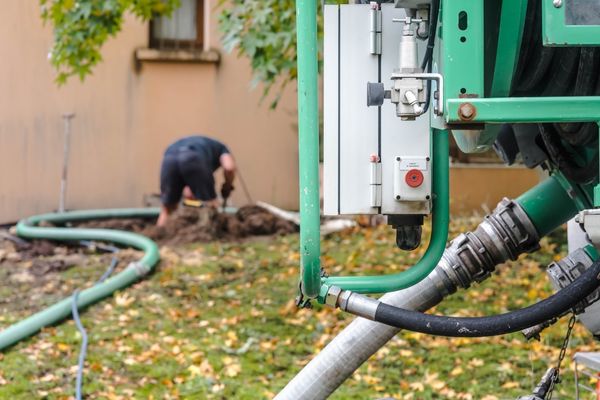Top Aerobic Septic System Risk During Heavy Rain
If you have an aerobic septic system, it’s important to know what to do if it experiences heavy rain. In this guide, we’ll look at the potential risks and solutions associated with an aerobic septic system during a period of heavy rain, so you can be prepared at all times.
Minimal Aeration
Aerobic septic systems need air to work properly, and heavy rain can interfere with the oxygen supply. If the system isn’t well-ventilated, it can lead to solids overloading or a decrease in the efficiency of the bacteria, causing discharge waste to not be treated properly and ultimately polluting surrounding water sources. To address this issue, check to ensure your aerobic system is being properly aerated– if needed, consider adding an additional aerator or replacing outdated ones.
Overflowing of Wastewater Tanks
Heavy rains can raise the water levels in the tanks and, if not properly monitored, wastewater can overflow and contaminate the surrounding environment. Proper maintenance of the aerobic tank is key– tanks should be checked periodically for high water volume levels and clogged filter systems. Additionally, taking preventive measures such as grading to divert runoff away from your aerobic septic system, adding an additional aerator for additional oxygen supply, or connecting to a sump pump system are effective ways to mitigate potential issues resulting from heavy rain.
Less Treatment Capacity
During heavy rains, the tank may become overwhelmed with wastewater and be unable to properly treat the volume. This can reduce the system’s ability to filter contaminants out of the water, resulting in higher levels of pollution going into the soil. In extreme cases, this could cause a sewage backup in your home as well. To counter this issue, regularly monitor your aerobic septic system for high water levels and ensure it has enough oxygen supply by adding an additional aerator if needed.
Increased Risk of Contamination
When an aerobic septic system is overwhelmed with more water than it can handle during a heavy rainstorm, there is an increased risk of contaminants entering the ground. This includes bacteria, viruses and other disease-causing microorganisms that can spread quickly and cause serious health issues if they come into contact with humans or animals. Furthermore, these contaminants can also infiltrate groundwater supplies, making them unsanitary or unusable for drinking.
Increase in Maintenance Requirements
Aerobic septic systems require regular maintenance to keep them running efficiently and prevent the risks associated with heavy rain. This includes checking system components such as the membranes, pumps, and filter media on a monthly basis, as well as troubleshooting issues that arise throughout the year. It’s important to do your research and always use a certified technician or expert to ensure that the system is in optimal condition when there is a chance of heavy rain.

How to Protect an Aerobic Septic System During Heavy Rainfall
When it comes to aerobic septic systems, managing your system in the face of heavy rains is essential to its long-term health and functioning. This guide covers everything you need to know about how heavy rain can impact an aerobic septic system and what you can do to protect it.
Monitor water levels
Monitoring the water level in your aerobic septic system is an important way to protect it from heavy rains. If the water in your tank climbs too high, this can cause trouble for your aeration equipment, as well as risk a potential overflow of wastewater. To avoid any issues, make sure you check the water level regularly and drain any excess water, if necessary.
Limit run-off from vehicles and lawns
Additionally, it’s important to be mindful of what is entering the aerobic septic system from outside sources. Limit run-off from vehicles and lawns by making sure that your driveway is sloped away from the tank, and your yard is properly graded to direct runoff away from your system. You should also avoid activities such as washing cars or watering sprinklers near the tank in order to minimize any external contaminants getting into your system.
Pump out excess wastewater and solid waste from the tank
Heavy rainfall can lead to an excessive buildup of wastewater and solid waste in the tank. To prevent overflow and minimize stress on the system, it’s best to pump out any excess water or solids that have built up in the tank during heavy rains. Note that pumping too often may cause damage to your system so be sure to exercise caution when determining how often to pump out the tank.
Upgrade your system as necessary to cope with increased rainfall amounts
Depending on the age and condition of your aerobic septic system, you may need to upgrade components in order to cope with increasing rainfall amounts. Upgrades could include an additional aeration pump, an enhanced filter system, or a bigger tank. If upgrading isn’t an option for you, consider planting rain gardens around your yard to absorb excess water. Additionally, ensure that the ground around your tank’s lid is graded away from it so that excess runoff can be diverted away from your septic system.
Regularly inspect tank, pipes, and other aeration components for signs of leaks or blockages
Regularly conducting a visual inspection of your septic system and its components is the best way to detect any signs of leaks or blockages caused by heavy rainfall. Inspect the aerobic tank, all incoming and outgoing pipes, air release valves, electric pumps, and any other aeration components for signs of damage or clogs. If you identify any leaks or blocked pipes that need repairing, be sure to have them fixed right away to prevent further damage.

